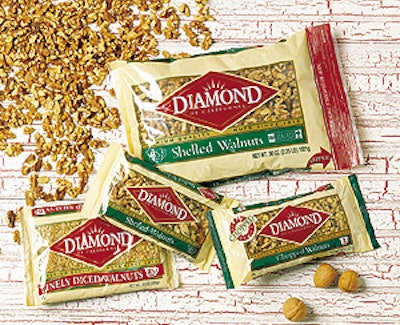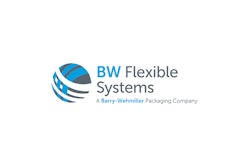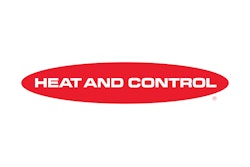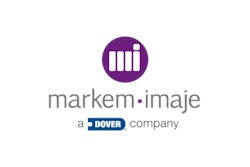
Outdated machinery that could no longer keep pace with increasing volume demands, along with the need to apply zippers to its bags of nuts, led Diamond of California to invest in new vertical form/fill/seal machinery at its Stockton, CA, facility. The results: Increased speed and output with reduced product giveaway and less machine downtime.
“We were looking to get more throughput,” says Dennis Bettencourt of the company’s decision to invest in new packaging machinery. Bettencourt, the company’s engineering manager, says, “the older units were early seventies-vintage machines, and replacement parts for them were hard to come by. We had problems with their older electronics and control boards, and machine efficiencies in the 60-percent range led us to make a change,” he says.
Bettencourt explains that the low efficiency was primarily attributable to the downtime necessary to maintain the aging equipment and either make do with older parts or wait for replacements. Although the older vf/f/s machinery performed well for the better part of two decades, it is now used sparingly.
Equipment upgrades were also necessary to fill Diamond’s growing sales volume, especially for its smaller bag sizes in both its retail and foodservice business. Business was expanding not only with walnuts, but also for what it calls its “culinary” nut business. Culinary nuts include pecans, almonds, pine nuts, macadamia, and other varieties used in baking and cooking. Many of these nuts are packed into bags that are hole-punched for pegboard display; however, some larger sizes of certain culinary nut varieties are filled into zippered bags. This expanded product line, along with some business acquisitions, led the nut growers cooperative to change its name from Diamond Walnut to Diamond of California in 1999.
Diamond of California spent about two years investigating equipment that could fill nuts in bags ranging from ½ oz to 5 lb, with or without zippers. It selected machinery from Hayssen (Duncan, SC), a Barry-Wehmiller company.
“We ran tests at different bagger makers, and they did a real good job with our products at Hayssen,” Bettencourt recalls. “They also have field service people in our area, and we were impressed with their commitment to us.” The equipment began running at Diamond just about two years ago.
Two new lines
The nut grower incorporates a transverse zipper into one end of 32-, 36-, and 40-oz lay-flat bags. Reclosable bags make it easy for consumers to either remove the product by hand or to pour the nuts out of the bag.
Diamond’s zippered bags are filled on an Ultra® Model 13-16 HR vertical form/fill/seal machine from Hayssen. This single-tube machine produces bags as small as 200 g (7.06 oz) at speeds up to 80 bags/min, and as large as 5-lb sizes at 20 bag/min speeds. This Ultra machine is equipped with a zipper applicator that applies the low-density polyethylene zipper material. A drive feeds the zipper from the spindle transversely to one side of the film. A knife cuts the zipper before it’s heat-sealed to the film.
The single-tube machine is referred to as Line 3 at the Stockton headquarters plant. It is one of two new Hayssen lines at the facility. The other new line, Line 4, is made up of an unusual “twin-tube” unit consisting of two vf/f/s machines fed by a single scale system. Like Line 3, this equipment was added in 2000. Unlike Line 3, it is currently not equipped to apply zippers.
Both lines use a computerized Ishida scale from Heat and Control (Hayward, CA). Along with these machines, the Stockton plant added new product-feeding conveyors, metal detectors, case and film coders, a case erector, case taper, and case labeler (see sidebar).
The main difference in the scale systems is as follows: Line 3 uses a combination of any of 14 buckets to accurately fill one bag on the single vf/f/s machine. The 16-head scale system on Line 4 is configured so that a combination of eight scales dumps an accurate product load into one of the twin-tube machines, while the other eight scales serve the second side-by-side Hayssen. The 16-head system includes an upper scale with a “booster” hopper directly beneath. Nuts released from the scale fall through one of two stainless-steel tubes that direct the product to either the “A” or “B” machine.
Twin-tube approach
Diamond selected this twin-tube approach because it had used a similar method before. The company was also confident that the computerized scale could supply ample product for both vf/f/s machines.
The packaging process is similar for both lines, but this article focuses on the more unusual Line 4. On this line, the twin-tube Hayssen Ultra Duplex Model 13-16 produces nonzippered bags from
200 g (7.06 oz), at speeds of 130 bpm, to 3-lb sizes at 70/min. The 36-oz sizes are filled at about 50 bags/min on Line 3.
Product is dumped from a large stainless-steel bin that holds up to 2귔 lb of product, down through what Diamond refers to as an “air leg” that reduces meal or fines from the nut mixture. It does this by pulling the meal out by means of a cyclone with a centrifugal fan. Product then descends onto a vibratory conveyor that delivers nuts into the 16-head Ishida scale system.
On the vf/f/s machine, film is pulled through a series of tensioning rollers. As the film unwinds toward the forming collar, it receives a date code from a Markem (Keene, NH) Model 2i unit that applies a best-before date in either white or black ink, depending on the background of the printed film.
Diamond relies on three converters for packaging, which is reverse-printed flexographically in five to eight colors, depending on the variety. The nut cooperative uses 2- to 3-mil film laminations that provide oxygen, moisture, and light barriers, though structures vary based on specific product requirements.
Film is pulled down over the tube, with heat used to create a back seal. A set of heated sealing jaws seals the bottom of the tube. Product is dumped from the scales into the bottom-sealed tube. Diamond nitrogen-flushes out ambient air that could cause rancidity in the nuts. Shelf life for the products is approximately 24 months.
Sealing jaws seal the top of the filled tube, simultaneously forming the bottom of the next bag. A knife cuts between the seal area, separating the filled pack from the next bag. The filled pack falls onto a conveyor that runs perpendicular to the two Hayssen machines, receiving bags from both machines.
A mechanical device incorporated within the conveyor gently tamps down each pack before it is conveyed through a metal detector to downstream manual case packing. No checkweighing is done on the lines. Settled bags are easier for operators to stack in cases, according to Bettencourt.
Detailing the benefits
Jim Puckett, maintenance supervisor, explains that one of the important benefits the Hayssen machines provide concerns changeovers. “With the old machines, all the adjustments were mechanical,” he tells Packaging World during a recent visit to the Stockton plant. “We had to make changes by hand on the machine.”
David Baffoni, manufacturing manager, elaborates. “Over time, as our company develops new products, we have more items to run on the machines. There’s a whole litany of tasks we go through from cleaning to inspecting the line, not to mention creating the product recipes. With the old equipment, we had to constantly monitor and adjust the scales, and physically change the tare weights in them because we had difficulties with the older bulk-and-dribble scales. Now, with the Ishida, it’s a simple push-button set-up. We have programmed recipes, and the main change is for the filling tubes.”
“Changeovers vary in number, but we generally do about three a week per machine,” adds Puckett. “Now changeovers are all programmable and we do them in about 20 minutes, compared to about 45 minutes in the past.”
Quicker changeovers mean labor savings. Further labor savings come from spending less time maintaining the new machines compared to their predecessors. Diamond would not reveal total annual labor savings figures, however.
Product accuracy from the scales is another critical benefit. “We’ve reduced product giveaway on average by 20 to 25 percent,” Baffoni estimates.
Speed and output gains are also critical benefits. “With the old systems we could run about 35 bags per minute per side on our 2.25-ounce packs,” Baffoni recalls. “Now we’re at 65 bags per minute per side. The accuracy of the scales allows us to attain those speeds, which we couldn’t before because we had problems with the previous bulk-and-dribble scales. The faster we ran the form/fill/seal equipment, the less accurate our fills became.”
Overall, Baffoni says that flexibility is a major advantage. “We can run anything from a one-half ounce to a five-pound bag,” he notes. To maximize the plant’s flexibility, Diamond expects to add more of those machines and scales as necessary, as well as continuing to make use of its older equipment.
See sidebar to this article: Downstream, upstream efficiency



























